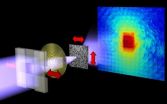(Press-News.org) CAMBRIDGE, Mass. -- The peaks of the Himalayas are a modern remnant of massive tectonic forces that fused India with Asia tens of millions of years ago. Previous estimates have suggested this collision occurred about 50 million years ago, as India, moving northward at a rapid pace, crushed up against Eurasia. The crumple zone between the two plates gave rise to the Himalayas, which today bear geologic traces of both India and Asia. Geologists have sought to characterize the rocks of the Himalayas in order to retrace one of the planet's most dramatic tectonic collisions.
Now researchers at MIT have found that the collision between India and Asia occurred only 40 million years ago — 10 million years later than previously thought. The scientists analyzed the composition of rocks from two regions in the Himalayas, and discovered evidence of two separate collisional events: As India crept steadily northward, it first collided with a string of islands 50 million years ago, before plowing into the Eurasian continental plate 10 million years later.
Oliver Jagoutz, assistant professor of geology in MIT's Department of Earth, Atmospheric and Planetary Sciences, says the results, which will be published in Earth and Planetary Science Letters, change the timeline for a well-known tectonic story.
"India came running full speed at Asia and boom, they collided," says Jagoutz, an author of the paper. "But we actually don't think it was one collision … this changes dramatically the way we think India works."
'How great was Greater India?'
In particular, Jagoutz says, the group's findings may change scientists' ideas about the size of India before it collided with Asia. At the time of collision, part of the ancient Indian plate — known as "Greater India" — slid underneath the Eurasian plate.
What we see of India's surface today is much smaller than it was 50 million years ago. It's not clear how much of India lies beneath Asia, but scientists believe the answer may come partly from knowing how fast the Indian plate migrates, and exactly when the continent collided with Asia.
"The real question is, 'How great was Greater India?'" Jagoutz says. "If you know when India hit, you know the size of Greater India."
By dating the Indian-Eurasian collision to 10 million years later than previous estimates, Jagoutz and his colleagues conclude that Greater India must have been much smaller than scientists have thought.
"India moved more than 10 centimeters a year," Jagoutz says. "Ten million years [later] is 1,000 kilometers less in convergence. That is a real difference."
Leafing through the literature
To pinpoint exactly when the Indian-Eurasian collision occurred, the team first looked to a similar but more recent tectonic example. Over the last 2 million years, the Australian continental plate slowly collided with a string of islands known as the Sunda Arc. Geologists have studied the region as an example of an early-stage continental collision.
Jagoutz and his colleagues reviewed the geologic literature on Oceania's rock composition. In particular, the team looked for telltale isotopes — chemical elements that morph depending on factors like time and tectonic deformation. The researchers identified two main isotopic systems in the region's rocks: one in which the element lutetium decays to hafnium, and another in which samarium decays to neodymium. From their analysis of the literature, the researchers found that rocks high in neodymium and hafnium isotopes likely formed before Australia collided with the islands. Rocks high in neodymium and hafnium probably formed after the collision.
Heading to the Himalayas
Once the team identified the isotopic signatures for collision, it looked for similar signatures in rocks gathered from the Himalayas.
Since 2000, Jagoutz has trekked to the northwest corner of the Himalayas, a region of Pakistan and India called the Kohistan-Ladakh Arc. This block of mountains is thought to have been a string of islands that was sandwiched between the two continents as they collided. Jagoutz traversed the mountainous terrain with pack mules and sledgehammers, carving out rock samples from the region's northern and southern borders. His team has brought back three tons of rocks, which he and his colleagues analyzed for signature isotopes.
The researchers split the rocks, and separated out more than 3,000 zircons — micron-long crystals containing isotopic ratios. Jagoutz and his colleagues first determined the age of each zircon using another isotopic system, in which uranium turns slowly to lead with time. The team then measured the ratios of strontium to neodymium, and lutetium to hafnium, to determine the presence of a collision, keeping track of where each zircon was originally found (along the region's northern or southern border).
The team found a very clear signature: Rocks older than 50 million years contained exactly the same ratio of isotopes in both the northern and southern samples. However, Jagoutz found that rocks younger than 50 million years, along the southern boundary of the Kohistan-Ladakh Arc, suddenly exhibited a range of isotopic ratios, indicating a dramatic tectonic event. Along the arc's northern boundary, the same sudden change in isotopes occurs, but only in rocks younger than 40 million years.
Taken together, the evidence supports a new timeline of collisional events: Fifty million years ago, India collided with a string of islands, pushing the island arc northward. Ten million years later, India collided with the Eurasian plate, sandwiching the string of islands, now known as the Kohistan-Ladakh Arc, between the massive continents.
"If you actually go back in the literature to the 1970s and '80s, people thought this was the right way," Jagoutz says. "Then somehow the literature went in another direction, and people largely forgot this possibility. Now this opens up a lot of new ideas."
INFORMATION:
This research was supported by a grant from the National Science Foundation.
Written by Jennifer Chu, MIT News Office
END
UNIVERSITY PARK, Pa. -- Preserving genetically diverse local crops in areas where small-scale farms are rapidly modernizing is possible, according to a Penn State geographer, who is part of an international research project investigating the biodiversity of maize, or corn, in hotspots of Bolivia, Peru and Mexico.
Hotspots are areas where cultivation of peaches and other non-traditional crops has exploded over the past decade, noted Karl Zimmerer, professor and head of the Department of Geography, and where small-scale farms are often female-run and have been previously ...
HERSHEY, Pa. --A compound that stimulates the production of a tumor-fighting protein may improve the usefulness of the protein in cancer therapy, according to a team of researchers.
TRAIL is a natural anti-tumor protein that suppresses tumor development during immune surveillance -- the immune system's process of patrolling the body for cancer cells. This process is lost during cancer progression, which leads to uncontrolled growth and spread of tumors.
The ability of TRAIL to initiate cell death selectively in cancer cells has led to ongoing clinical trials with artificially ...
Bad news about the economy could cause you to pack on the pounds. This according to a new study from the University of Miami School of Business Administration published in the February edition of Psychological Science, a journal of the Association of Psychological Science. The study shows that when there is a perception of tough times, people tend to seek higher-calorie foods that will keep them satisfied longer. When subconsciously primed with such messages, a "live for today" impulse is triggered causing people to consume nearly 40 percent more food than when compared ...
With help from a wind tunnel and the latest DNA technology, U.S. Department of Agriculture (USDA) scientists are shedding light on the travel patterns of microbes in soils carried off by strong winds. The work has implications for soil health and could lead to management practices that minimize the damage to soils caused by wind erosion.
Wind erosion is an emerging issue in soil conservation efforts. Agricultural Research Service (ARS) scientists have been studying wind-eroded soils since the 1930s, but few studies have focused on the effects of wind on the bacteria, ...
INDIANAPOLIS -- Medical literature long has touted the benefits of omega-3 fatty acids for the heart. But until now, researchers have not studied the potential benefit for people on hemodialysis, who are among the highest-risk patients for sudden cardiac death.
A study published Feb. 6 online in the journal Kidney International, which included 100 patients who died of sudden cardiac death during their first year of hemodialysis and 300 patients who survived, is the first to examine this question.
Allon N. Friedman, M.D., associate professor of medicine in the Division ...
SAN FRANCISCO, Feb. 6, 2013 -- Nitrogen in ocean waters fuels the growth of two tiny but toxic phytoplankton species that are harmful to marine life and human health, warns a new study published in the Journal of Phycology.
Researchers from San Francisco State University found that nitrogen entering the ocean -- whether through natural processes or pollution -- boosts the growth and toxicity of a group of phytoplankton that can cause the human illness Amnesic Shellfish Poisoning.
Commonly found in marine waters off the North American West Coast, these diatoms (phytoplankton ...
Since the observations made by English naturalist Charles Darwin on the Galapagos Islands, researchers have been interested in how physical barriers, such as isolation on a particular island, can lead to the formation of new species through the process of natural selection. Natural selection is a process whereby heritable traits that enhance survival become more common in successive generations, while unfavorable heritable traits become less common. Over time, animals and plants that have morphologies or other attributes that enhance their suitability to a particular environment ...
ANN ARBOR—Hunger, thirst, stress and drugs can create a change in the brain that transforms a repulsive feeling into a strong positive "wanting," a new University of Michigan study indicates.
The research used salt appetite to show how powerful natural mechanisms of brain desires can instantly transform a cue that always predicted a repulsive Dead Sea Salt solution into an eagerly wanted beacon or motivational magnet.
Mike Robinson, a research fellow in the U-M Department of Psychology and the study's lead author, said the findings help explain how related brain activations ...
AUDIO:
In the 1970s and early 1980s, some states lower their minimum legal drinking age below the age of 21. Those lower drinking ages have been linked to bad things, from...
Click here for more information.
People who grew up in states where it was legal to drink alcohol before age 21 are more likely to be binge drinkers later in life, according to a study by researchers at Washington University School of Medicine in St. Louis.
The findings are available online in Alcoholism: ...
For more than 100 years radiography meant: don't move! In order to visualize nanostructures such as biological cells, the porous structure of cement or storage fields of magnetic disks, the experimentators had to avoid any kind of vibration of X-ray microscope and sample. In addition, only a small percentage fraction of the incoming X-ray radiation could be used. Using special filters, they had to select exactly the fraction with the right properties – for example, the right wavelength.
Contributions of different wavelengths separated
Pierre Thibault of the Technische ...


